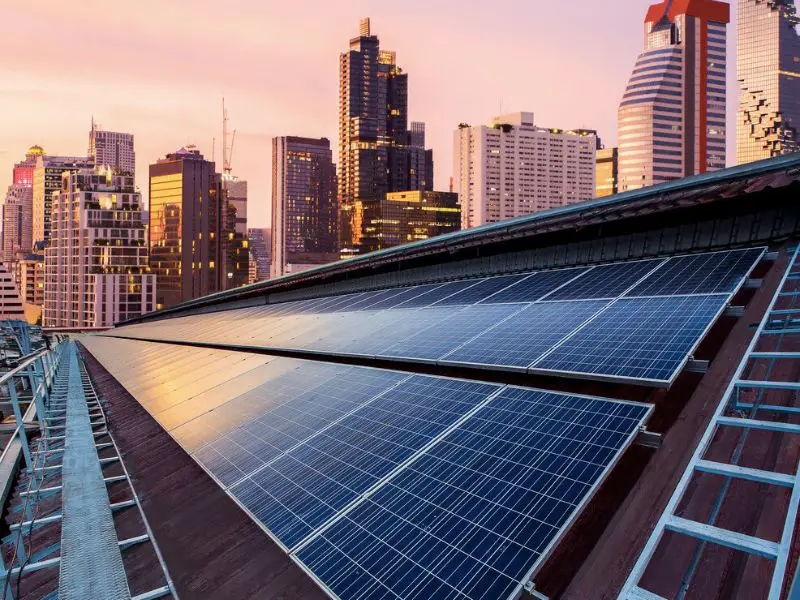Renewable energy growth is rising worldwide, revolutionizing how we generate power and offering a sustainable solution for the future. With impressive advancements in technologies such as wind and solar power, the global renewable energy sector has experienced remarkable expansion.
However, while progress is evident globally, regional differences in the pace of transformation exist. This article explores the current status of renewable energy growth, highlighting fundamental drivers and challenges and providing insights into this promising sector’s projected future.
Current Status of Renewable Energy Growth
Global Trends
Renewable energy is booming worldwide! The International Energy Agency (IEA) tells us we now have 295 gigawatts of green energy capacity. That’s a lot! According to a report from NPR, renewable energy capacity grew by a staggering 45% in 2020. It’s like a renewable energy gold rush, with wind and solar leading the way. So, get ready because this renewable energy growth train isn’t stopping anytime soon.
Regional Differences
Renewable energy growth has showcased remarkable progress globally; however, regional disparities exist in the transformation rate. The United States Energy Information Administration (EIA) foresees a substantial surge in the proportion of renewables within the U.S. electricity generation mix, projected to soar from 21% in 2020 to an impressive 42% by 2050.
The primary drivers behind this remarkable expansion are wind and solar generation. In Europe, the growth of renewable energy has been galvanized by the European Union’s Renewable Energy Directive, which established an ambitious objective of attaining 20% renewable sources within the energy mix by 2020.
Key Drivers of Growth
There are several key drivers behind the growth of renewable energy. One major factor is the declining cost of renewable energy technologies like solar and wind power. Another factor is government policies and regulations that incentivize the use of renewable energy.
For example, tax credits and subsidies can make renewable energy more cost-competitive with traditional energy sources. Additionally, public demand for clean energy and corporate sustainability goals drive demand for renewable energy.
Challenges to Renewable Energy Growth
Renewable energy growth has become increasingly important as the world moves towards a more sustainable future. However, despite the many benefits of renewable energy, several challenges must be overcome to achieve widespread adoption. This section will discuss some key challenges facing renewable energy growth, including infrastructure, policy and regulation, and technological limitations.
1. Infrastructure
One of the biggest challenges to renewable energy growth is more infrastructure. Renewable energy sources such as wind and solar require significant space and resources to generate electricity. This can be particularly challenging in densely populated areas or areas with limited resources.

The existing energy infrastructure is designed to handle something other than renewable energy sources. The current grid system was built for traditional fossil fuel power plants operating differently from renewable energy sources. This means that significant upgrades to the grid are necessary to accommodate renewable energy sources.
2. Policy and Regulation
Another challenge to renewable energy growth is more supportive policies and regulations. Many countries still heavily subsidize fossil fuels, making it difficult for renewable energy sources to compete economically. Additionally, there needs to be more consistent policies and regulations across different regions, which can create uncertainty for investors and slow the development of renewable energy projects.
Furthermore, there are often regulatory barriers to entry for renewable energy companies. For example, some countries require renewable energy companies to obtain permits and licenses, which can be time-consuming and expensive.
3. Technological Limitations
Finally, technological limitations must be overcome to achieve widespread renewable energy growth. For example, energy storage technology is still in its early stages, which means that excess energy generated by renewable sources cannot always be stored and used later. This limits the ability of renewable energy sources to provide reliable and consistent power.
Additionally, technological challenges are still associated with manufacturing and installing renewable energy systems. For example, producing solar panels requires significant energy, which can offset some environmental benefits of using renewable energy.
Solutions to Overcome Challenges
To accelerate renewable energy growth, you need to overcome several challenges. Here are some solutions to help you get there.
1. Investment and Financing
Investment and financing are crucial to renewable energy growth. Governments, private investors, and international organizations must invest in renewable energy projects to make them more affordable and accessible.
One way to attract investment is to provide incentives such as tax credits, subsidies, and low-interest loans. These incentives can reduce the cost of renewable energy projects and make them more attractive to investors.
Another way to finance renewable energy projects is through green bonds. Green bonds are a debt instrument that raises capital for projects with environmental benefits. They are becoming increasingly popular as investors look for socially responsible investment opportunities.
Discover the largest renewable energy companies leading the charge towards a sustainable future. Join the green revolution and harness the energy of the mighty renewables!
2. Innovation and Research
Innovation and research are also critical to renewable energy growth. New technologies and processes can help reduce the cost of renewable energy and make it more efficient.
Governments and private organizations must invest in research and development to create new technologies and improve existing ones. For example, research into battery storage technology can help make renewable energy more reliable by storing excess energy when it is generated and releasing it when needed.
3. Collaboration and Partnerships
Collaboration and partnerships are essential to overcome the challenges of renewable energy growth. Governments, private companies, and international organizations must collaborate to create a sustainable energy future.
Collaboration can take many forms, from sharing knowledge and expertise to joint research and development projects. Partnerships between public and private organizations can also create new investment opportunities and provide the funding needed to finance renewable energy projects.
Investing in renewable energy, innovating new technologies, and collaborating with others can help overcome the challenges of renewable energy growth and create a sustainable energy future.
Future Outlook
Looking ahead, the future of renewable energy growth is bright. As more countries commit to reducing their carbon emissions and transitioning to cleaner energy sources, the demand for renewable energy will continue to rise. This section will explore the projected growth of renewable energy, emerging technologies, and the potential impact on the environment and society.
Projected Growth
The International Energy Agency predicts that renewable energy will grow faster than any other source of electricity in the next decade. By 2030, renewable energy is expected to make up more than 80% of new power generation worldwide. This is due to lower costs of renewable technologies, increased government support, and a growing awareness of the importance of clean energy.
Emerging Technologies
In addition to the expansion of established renewable energy technologies, such as wind and solar power, several emerging technologies hold great potential for furthering the growth of renewable energy.
- Energy Storage: The intermittent nature of renewable energy sources, such as wind and solar, necessitates the deployment of energy storage technologies like batteries and pumped hydro storage. By ensuring a consistent supply of electricity, these storage solutions play a vital role in bolstering reliability.

- Hydrogen Fuel Cells: With the ability to generate electricity emission-free, hydrogen fuel cells offer promising prospects for powering various applications, including transportation. They contribute to advancing renewable energy goals as clean and efficient technology.
- Wave and Tidal Power: Harnessing the immense power of ocean waves and tides, wave, and tidal power technologies have emerged as potentially significant contributors to renewable energy. By converting the kinetic energy of these natural forces into electricity, they offer a renewable and abundant power source.
Potential Impact on the Environment and Society
The surge in renewable energy growth stands as a beacon of promise, not only for our environment but also for our society. Think about it: by dialing back our dependency on fossil fuels, we can slash the emissions of harmful greenhouse gases and help cool down the global warming issue. The rising wave of renewable energy can open fresh job opportunities and rev up economic growth – especially in our countryside communities.
Yet, we’ve got to tread carefully here. The renewable energy growth we’re witnessing must be balanced and sustainable without causing some unexpected downside. Take this, for example; the build-out of massive renewable energy infrastructure could lead to some not-so-green effects, like destroying natural habitats or altering land usage. We must weigh up the possible impacts of renewable energy projects and do what we can to reduce adverse outcomes.
When you take it all in, the future of renewable energy growth seems bright. As long as we keep the pedal to the metal with innovation and investment, renewable energy can step up to the plate to satisfy our energy cravings and do it in a way that lessens our footprint on our planet.

